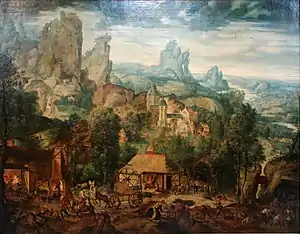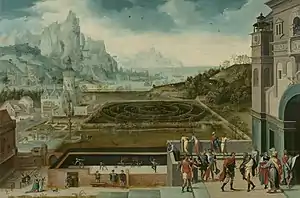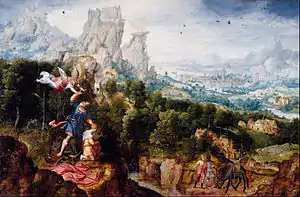Herri met de Bles
Herri met de Bles (also known as Henri Blès, Herri de Dinant, Herry de Patinir, and il Civetta) (born c. 1490 - after 1566) was a Flemish Northern Renaissance and Mannerist landscape painter, native of Bouvignes or Dinant (both in present-day Belgium).[1][2][3]

He contributed, along with Joachim Patinir, to a distinct style of Northern Renaissance landscape painting that combined small history or religious scenes into compositions defined by perspective and atmospheric effects. They both painted landscapes seen from a high viewpoint and rocky masses. They did not aim to create a realistic depiction but an atmospheric effect. Herri met de Bles always included a few small figures involved in a religious episode or everyday activities such as mining, agriculture or trade.
Life

The Netherlands Institute for Art History suggests that de Bles was born in Antwerp in circa 1510.[2] Very little is known about the artist. He is believed to be identical to a certain Herry de Patenir who joined Antwerp's Guild of St. Luke in 1533 as a painter. He may have been related to the landscape painter Joachim Patinir, perhaps as his nephew, although he may not have trained under him because of their age difference.[4]
He may have visited Ferrara, Italy and died there, getting buried in the church of San Giacomo, as an Italian source mentions it, but there is no documentary evidence for this. [5] His work was popular in Italy, where he was known as 'il Civetta' because of the little owl that often appears in his paintings, usually in a hollow tree or in a cavity between some rocks. The 17th-century biographer Karel van Mander regarded this motif as his signature.[6] The name Herri met de Bles translates literally from Dutch as Herri with the blaze and was reportedly given him because of his characteristic white forelock.
The notname of "Pseudo Bles" was invented to cover a number of Antwerp Mannerist paintings that had previously been attributed to de Bles, after it was recognised that this was wrong. In 1915 by Max Jakob Friedländer in his work Die Antwerpener Manieristen von 1520, made a first attempt to put order in the growing number of works from the Netherlands that were catalogued under the 'name of embarrassment 'pseudo-Herri met de Bles' (usually now "Pseudo Bles").[7]
Older sources date his death vaguely to around or after 1550 or 1555,[8] but the RKD now places him as still active in Antwerp in 1566.[2]
Work

His landscapes are different from Patinir's in that de Bles' work shows more foreground landscapes, a looser composition and greater detail. His choice of colours is generally less rich than that of Patinir.[6] Along with a group of Antwerp-based followers of Hieronymus Bosch that included Jan Mandyn, Pieter Huys, and Jan Wellens de Cock, de Bles brought the tradition of fantastic imagery into northern Mannerism.
Trivia
In Richard Powers's novel, "The Gold Bug Variations (1991)," one of the main characters is working on a dissertation whose subject is Herri met de Bles. The painter's obscurity and his peculiar imagery are woven into the motifs of the novel.
Notes
- Fraiture, Pascale (2 November 2004). "Contribution of scientific methods to the understanding of the work of the 16th century painter, Henri Bles". Dendrochronologia. 20 (3): 285–299. doi:10.1078/1125-7865-00022.
- Herri met de Bles at the Netherlands Institute for Art History (in Dutch)
- https://www.hampel-auctions.com/a/Herri-met-de-Bles-1490-1560.html?a=64&s=2&id=53534&g=Gemaelde-16-18-Jhdt
- Liechtenstein, the Princely Collections, Metropolitan Museum of Art, 1985, pp. 279–280
- le muse, III, Novara, De Agostini, 1964, pp. 319-320.
- Hans Devisscher: "Bles [Blesio, Blesius, Blessio; de Dinant, de Patinir], Herri met de [Henri, Henrico; Herry (met de)] [Civetta]" Grove Art Online. Oxford University Press, [accessed 11 July 2014]
- Max J. Friedländer: Die Antwerpener Manieristen von 1520. In: Jahrbuch der königlich preußischen Kunstsammlungen 36, 1915, p. 65–91, p. 65 (in German)
- for example ULAN
References
- Norman E. Muller (Ed.): Herri met de Bles: Studies and Explorations of the World Landscape Tradition. Brepols, Turnhout 1998, ISBN 0-943012-25-2
- Michel Weemans. "Herri met de Bles's sleeping peddler: an exegetical and anthropomorphic landscape". Art Bulletin, Sept 2006.
- Weemans, Michel. "Herri Met de Bles's Way to Calvary: A Silenic Landscape," Art History, 32,2 (2009), 307-331.
External links
| Wikimedia Commons has media related to Herri met de Bles. |